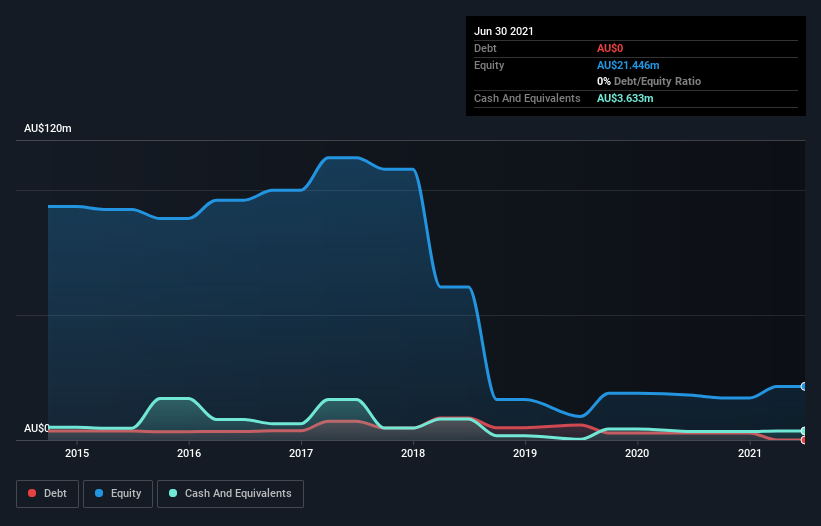Here's Why We're Not At All Concerned With Carnegie Clean Energy's (ASX:CCE) Cash Burn Situation
Even when a business is losing money, it's possible for shareholders to make money if they buy a good business at the right price. By way of example, Carnegie Clean Energy (ASX:CCE) has seen its share price rise 200% over the last year, delighting many shareholders. Having said that, unprofitable companies are risky because they could potentially burn through all their cash and become distressed.
So notwithstanding the buoyant share price, we think it's well worth asking whether Carnegie Clean Energy's cash burn is too risky. For the purpose of this article, we'll define cash burn as the amount of cash the company is spending each year to fund its growth (also called its negative free cash flow). The first step is to compare its cash burn with its cash reserves, to give us its 'cash runway'.
View our latest analysis for Carnegie Clean Energy
Does Carnegie Clean Energy Have A Long Cash Runway?
A cash runway is defined as the length of time it would take a company to run out of money if it kept spending at its current rate of cash burn. In June 2021, Carnegie Clean Energy had AU$3.6m in cash, and was debt-free. In the last year, its cash burn was AU$1.1m. So it had a cash runway of about 3.2 years from June 2021. A runway of this length affords the company the time and space it needs to develop the business. Importantly, if we extrapolate recent cash burn trends, the cash runway would be noticeably longer. You can see how its cash balance has changed over time in the image below.
How Is Carnegie Clean Energy's Cash Burn Changing Over Time?
Whilst it's great to see that Carnegie Clean Energy has already begun generating revenue from operations, last year it only produced AU$61k, so we don't think it is generating significant revenue, at this point. Therefore, for the purposes of this analysis we'll focus on how the cash burn is tracking. Even though it doesn't get us excited, the 46% reduction in cash burn year on year does suggest the company can continue operating for quite some time. Carnegie Clean Energy makes us a little nervous due to its lack of substantial operating revenue. We prefer most of the stocks on this list of stocks that analysts expect to grow.
How Hard Would It Be For Carnegie Clean Energy To Raise More Cash For Growth?
While Carnegie Clean Energy is showing a solid reduction in its cash burn, it's still worth considering how easily it could raise more cash, even just to fuel faster growth. Companies can raise capital through either debt or equity. Many companies end up issuing new shares to fund future growth. By comparing a company's annual cash burn to its total market capitalisation, we can estimate roughly how many shares it would have to issue in order to run the company for another year (at the same burn rate).
Carnegie Clean Energy's cash burn of AU$1.1m is about 2.6% of its AU$45m market capitalisation. That means it could easily issue a few shares to fund more growth, and might well be in a position to borrow cheaply.
So, Should We Worry About Carnegie Clean Energy's Cash Burn?
As you can probably tell by now, we're not too worried about Carnegie Clean Energy's cash burn. In particular, we think its cash runway stands out as evidence that the company is well on top of its spending. But it's fair to say that its cash burn reduction was also very reassuring. After taking into account the various metrics mentioned in this report, we're pretty comfortable with how the company is spending its cash. On another note, we conducted an in-depth investigation of the company, and identified 4 warning signs for Carnegie Clean Energy (1 is a bit concerning!) that you should be aware of before investing here.
Of course Carnegie Clean Energy may not be the best stock to buy. So you may wish to see this free collection of companies boasting high return on equity, or this list of stocks that insiders are buying.
This article by Simply Wall St is general in nature. We provide commentary based on historical data and analyst forecasts only using an unbiased methodology and our articles are not intended to be financial advice. It does not constitute a recommendation to buy or sell any stock, and does not take account of your objectives, or your financial situation. We aim to bring you long-term focused analysis driven by fundamental data. Note that our analysis may not factor in the latest price-sensitive company announcements or qualitative material. Simply Wall St has no position in any stocks mentioned.
Have feedback on this article? Concerned about the content? Get in touch with us directly. Alternatively, email editorial-team (at) simplywallst.com.

 Yahoo Finance
Yahoo Finance 
